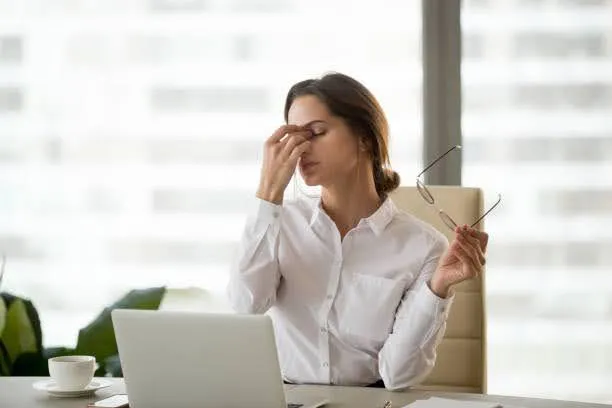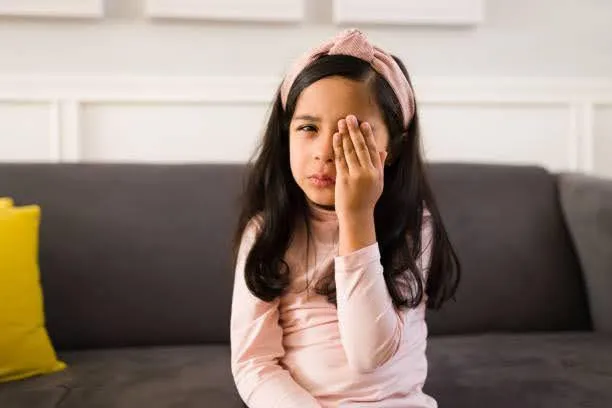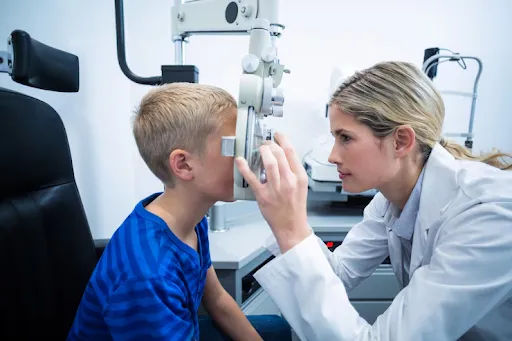Kleinwood Vision
Blog
FSDAVCFEBFEVSDDVFSD
FSDAVCFEBFEVSDDVFSD
FSDAVCFEBFEVSDDVFSD

Myopia Tools
Vision Logs That Truly Drive Results
Tracking vision only works when it stays simple. A daily vision tracking log should include the essentials: hours lenses were worn, comfort clarity scores rated 0–10, outdoor minutes, and the longest near-work stretch. If illness or skipped days occur, noting the reason helps your doctor link symptoms to habit changes...

Digital Habits
After-School Myopia Routine Guide
Start with water and a protein snack, then aim for 30–60 minutes outside. Daylight and movement help focusing systems reset after class, easing strain before homework. If weather or daylight is limited, choose a bright area near a window and open the curtains wide. Keep shoes by the door to make the step outside automatic.

Myopia Care
Switching from MiSight® to Ortho-K
Active kids who want glasses-free days, play contact sports, or need stronger control under heavy near work often benefit from a myopia control transition from MiSight® to Ortho-K. Families may also consider the change when daily disposables are hard to manage, when school or travel disrupts routines, or when axial growth remains above axial length targets...

Workplace Care
Sclerals at Work: Stay Protected
Airborne particulates, solvents, and heat challenge tear film and lens surfaces. Scleral lenses work safety habits are vital—wear ANSI-rated wraparound safety glasses or sealed goggles as PPE over contacts. Keep preservative-free saline vials handy for controlled refreshes...

Digital Habits
A Myopia-Safe Screen Time Contract
Keep the contract short and specific: distance (forearm “reading distance child” rule), break cadence (20-20-20 rule family), larger text, raised screens, and clear device bedtime limits. Assign roles: the child runs timers and logs activity, while the parent reviews and praises effort, not perfection...

Myopia Care
Axial Reports: Parent Reading Guide
Baseline is the first accurate optical biometry results reading; it anchors every future comparison on your child’s axial length report. Trend shows change since baseline and the annualized mm per year myopia rate, which predicts long-term risk better than glasses power alone.

Myopia Care
Safe Lens Habits During Illness
Fever, dehydration, and inflamed nasal passages destabilize the tear film and raise infection risk. Cold medicines can dry the eyes and lids, increasing deposits and irritation. During colds or flu, the safest rule for contacts when sick is simple: switch to glasses, hydrate, and rest.

Myopia Care
Allergy-Smart Strategies for Myopia Control
Histamine makes eyes itchy and watery, tempting rubbing and introducing deposits that reduce comfort and clarity. Tear chemistry also shifts with pollen exposure, making itchy eye contacts more likely to fog or feel gritty. Even perfect technique struggles when lids...

Pediatric Care
Pediatric Dilation: What to Expect
Dilation lets us examine the retina, optic nerve, and blood vessels clearly during a dilated retinal exam child. It also relaxes the focusing system so we can perform accurate cycloplegic refraction children—the gold standard for measuring true prescription. Strong focus can mask farsightedness ...

NeuroLens
NeuroLens for Coders Using Multiple Monitors
Center your primary monitor and angle secondary screens slightly inward to reduce neck rotation and eye movement. Keep top bezels at or just below eye level, about...

NeuroLens
NeuroLens for Safer, Easier Driving
Long hours of steady focus, dashboard glances, and mirror checks strain the eyes’ alignment system. Even slight misalignments can build into headaches, neck tension, and fatigue late in the drive. NeuroLens for drivers measures these alignment gaps and applies contoured ...

Specialty Contacts
Scleral Lenses After LASIK Ectasia
Post-LASIK ectasia creates irregular optics and dryness that soft lenses can’t neutralize. Sclerals vault the cornea, holding a smooth saline reservoir that masks irregularity and protects sensitive tissue. Comfort comes from resting on the white of the eye, not the cornea.

Specialty Contacts
Hybrid Lenses for Post-Surgical Vision
Laser procedures can leave corneas with irregular optics that soft lenses alone can’t fully correct. Hybrid lenses place a GP center over the post-surgical cornea for crisp focus, with a soft skirt for comfort and centration. Many patients find comfort-clarity hybrids ideal for screens, meetings, and errands...

Pediatric Care
Sensory-Friendly Myopia Routines for Kids
Use a simple visual schedule with photos for each step—wash, insert or dose, log, reward—posted at the sink and bedside. Keep supplies in labeled bins and pick preferred textures, like soft, non-scented towels and gentle, unscented soaps. Practice at the same ...

Lens Care
Lens Case Hygiene That Works
Biofilm is a sticky community of microbes that clings inside cases and resists ordinary rinsing. Tap water adds organisms like Acanthamoeba, which thrive in moist plastic and threaten eye health. Even clean-looking wells can hide growth invisible to the eye; that’s why science stresses prevention.

Specialty Contacts
Scleral Saline: Safe Choices & Use
Scleral lenses hold saline against the cornea for hours, so the solution’s ingredients matter. Using preservative-free scleral saline protects sensitive tissues and keeps optics crisp. Unit dose saline lenses reduce preservative exposure and limit germ growth compared with multi-use bottles. Because the lens bowl seals fluid on the eye, even small irritants can cause stinging or...

Specialty Contacts
Understanding Toric Multifocal Contact Lenses Clearly
Toric lenses address the uneven corneal shape that causes astigmatism, while multifocal optics provide zones for near and distance tasks. Bringing both together enables myopic astigmatism correction in a single design. Success depends on rotational stability, precise alignment, and a specialty contact fit that respects corneal ...

Summer Care
Swim-Safe Ortho-K Summer Guide for Kids
Tap, pool, and lake water can harbor microbes like Acanthamoeba that cause painful infections. Ortho-K lenses are for dry eyes only—never for swimming, even with goggles. Water exposure raises infection risk and can threaten vision. For Ortho-K swimming safety, remove lenses before any water activity and store them properly...

Digital Habits
Phone & Tablet Settings Guide
Increase text size to reduce squinting and hunching during homework. On iPhone, go to Settings → Display & Brightness → Text Size; on Android, Settings → Accessibility → Font Size. Enable Bold Text for clarity. On newer iPhones and iPads, activate Screen Distance Alerts to cue proper posture.

Myopia Care
Atropine At Home: Family Safety Guide
Label each atropine bottle clearly and follow pharmacy instructions for proper storage—some compounded pediatric myopia drops require refrigeration, others room temperature. Before the first dose, confirm your child’s name, concentration, and beyond-use date.

Myopia Care
MiSight® Compliance Playbook for Families
Post two short mirror checklists to keep MiSight® routines simple and consistent: morning—clean hands → insert → log; evening—remove → discard → log. Keep a “go kit” near the door with spare lenses, a pocket mirror, tissues, and doctor....

Ortho-K Care
Ortho-K Lens Materials and Oxygen Flow
During sleep, blinking slows and tear exchange decreases, limiting oxygen just as the cornea reshapes. That’s why high Dk lens material, precise center thickness, and smooth surface wetting are vital for overnight lens safety. These features protect the corneal health Ortho-K is designed ...

Pediatric Care
Myopia Kit for School Nurses
Include a parent myopia consent form, clinic contacts, medication permissions, and a one-page student profile listing lenses used, storage needs, and vision red flags kids may show. Add a small mirror, tissues, approved drops, and sterile saline vials for emergencies in a secure pouch. Clear labels prevent mix-ups and support a reliable nurse vision checklist following Kleinwood vision...

Myopia Care
Axial Length Plateau and Graduation
At Kleinwood Vision, an axial length plateau means the eye’s growth curve has truly flattened, not just that a glasses prescription looks steady. We track myopia stabilization in millimeters, using the same device and similar times of day to reduce noise. Trend lines—not one data point—guide decisions for families and our Houston myopia clinic.

Myopia Metrics
Axial Length vs Prescription: Two Vital Metrics
Prescriptions written in diopters describe how much focusing power a lens needs to help your child see clearly right now. In contrast, axial length—measured in millimeters—reveals how long the eye has grown, a key factor in long-term myopia risk. The two metrics move differently; a child’s prescription might change while axial growth slows, or the opposite.

Retinal Care
Retinal Imaging Steps for High Myopia
An elongated eye in high myopia stretches delicate retinal tissues, increasing high myopia retinal risks such as tears, detachments, and the need for myopic maculopathy screening. Since early retinal changes can occur without symptoms, scheduled retinal imaging works like a preventive smoke alarm—alerting doctors to issues before vision is affected.

Ortho-K Care
Ortho-K Safety for Kids: Essential Tips
Begin by washing hands with non-moisturizing soap, rinsing thoroughly, and air-drying completely—never use lotions before handling lenses. Use only lint-free towels to prevent fiber transfer, and keep fingernails trimmed to reduce the risk of damaging lenses or scratching eyes. Establish a dedicated “clean zone” at the sink: label all solution bottles clearly, store them upright, and
never...

Myopia Care
Myopia Control Costs Clearly Explained
When evaluating myopia control cost, most first-year programs at a Houston myopia clinic like Kleinwood Vision include key baseline exams such as refraction, corneal topography, and axial length measurement. Packages often cover lens or atropine fitting...

Specialty Contacts
Hybrid vs. Scleral: Choosing Well
Patients with keratoconus, corneal ectasia, or pellucid marginal degeneration often benefit from specialty lenses designed for their condition. Hybrid vs. scleral lenses is a common comparison. Hybrids have a rigid center with a soft skirt, offering both clarity and comfort. Scleral lenses vault over the cornea...

Specialty Contacts
Scleral Lens I&R Troubleshooting Guide
Start with clean hands—wash thoroughly and dry well. Set up a stable mirror, and place your scleral lens on the plunger or tripod stand. Fill the lens bowl completely with preservative-free saline to the rim, making sure there are no gaps that could trap...

Ortho-K Care
Toric Ortho-K: Candidacy & Results
Candidates for toric Ortho-K typically have moderate myopia combined with regular astigmatism and a stable sleep schedule. Corneal topography must show patterns compatible with steady lens centration. Lid anatomy and tear quality are also important for a safe and effective fit. These factors help determine if the eyes can support consistent overnight lens wear without complications.

Neuro Lens
NeuroLens + Ergonomics Guide for Comfort
Proper monitor placement is essential for anyone using contoured prism lenses like NeuroLens. For optimal comfort, place your monitor an arm’s length away, with the top edge at or just below eye level. If you use dual monitors, center the primary one and angle the secondary to reduce excessive head turning. Even with NeuroLens, poor screen angles can cause recurring eye...

Eye Health
NeuroLens Measurement Explained: What the NMD Test Reveals
Even a small misalignment between your eyes can cause major symptoms—chronic headaches, neck pain, eye strain, and visual fatigue. These issues are often tied to Binocular Vision Dysfunction (BVD), a condition where the eyes struggle to stay aligned during ...

Myopia Care
Complete MiSight® Fitting Day Guide
A good MiSight fitting starts at home with easy preparation. Encourage your child to get a restful night’s sleep and arrive with clean, dry hands and trimmed nails. Avoid heavy lotions, makeup, or eye creams to keep lenses clean and comfortable. Bring your child’s current glasses and notes about sports schedules and screen time habits. This helps the Houston myopia clinic tailor a wear plan fitting your child’s routine.

Ortho‑K Care
Ortho-K Nightly Care Routine Guide
Create a clean “drop zone” in your bathroom or vanity dedicated to your Ortho-K care. Stock it with gentle, non-moisturizing soap, a lint-free towel, a mirror at eye level, clearly labeled solution bottles, and spare plungers. Always wash hands for 20 seconds, including fingertips and nails, rinse thoroughly, and air-dry or use a clean paper towel. Avoid skincare, lotions, or creams before handling lenses, and keep nails trimmed to prevent...

Myopia Care
Axial Length Monitoring in Myopia Care
Axial length monitoring is essential in myopia control for kids. It measures how long the eye is from front to back—known as axial length—and even small increases can raise the lifetime risk of serious conditions like retinal detachment or myopic maculopathy. Unlike changes in glasses prescriptions, axial length progression offers insight into actual structure ...

Children’s Eyewear
Kid-Friendly Glasses for Safe Comfort
Choosing the right glasses for kids is essential to ensure they wear them consistently and comfortably. Glasses for kids should be made from durable materials like flexible plastics or memory metal to handle active use. Impact-resistant polycarbonate lenses provide both safety and clarity, making them ideal for children.

Contact Lenses
Wearing Contacts with Dry Eyes Comfortably
Wearing contact lenses can sometimes make dry eye symptoms worse, leading to discomfort and irritation. Since lenses sit on the tear film that protects your eyes, this film can break down faster in dry environments or after long screen use. As a result, wearers may experience redness, grittiness, or blurred vision after a few hours.

Eye Health
How NeuroLens Works to Relieve Eye Strain
Even a slight misalignment between your eyes can cause significant discomfort. Your eyes constantly try to stay aligned, but small discrepancies force the eye muscles to strain, leading to overstimulation of the trigeminal nerve—a major nerve that controls facial sensation and movement. This can result in symptoms like chronic headaches...

LASIK Alternatives
Alternatives When LASIK Isn’t Possible
Some people aren’t ideal LASIK candidates due to factors like thin or irregular corneas, unstable prescriptions, chronic dry eye, or being under age 18. LASIK requires a corneal flap of sufficient thickness and stable vision, which may pose risks in contact sports or physically demanding jobs. Conditions like keratoconus or early cataracts also disqualify many patients. Fortunately, not qualifying for LASIK doesn’t mean you can’t achieve clearer vision;which may pose risks in sports...

Eye Care Myths
Eye Care Myths Debunked for Better Vision
Many people fall for common eye care myths that create confusion and lead to poor vision habits. These myths often cause unnecessary fear or result in ineffective routines that don’t support real eye health. Learning the difference between vision facts vs myths is essential for making smart decisions about protecting your eyesight. At Kleinwood Vision, we offer science-based advice to help patients understand what truly benefits their eyes.

Pediatric Eye Care
Understanding Amblyopia and Early Treatment
Amblyopia, commonly known as lazy eye in children, is a vision development disorder where one eye has reduced vision because the brain favors the other. This can occur even if the eye is physically healthy, often due to strabismus (eye misalignment) or significant prescription differences between the eyes. Without early diagnosis, the weaker eye may not develop normal vision, leading to permanent impairment. Early pediatric eye exams ...

Myopia Control
Ortho-K and Atropine Dual Therapy
Children with myopia often face more than just blurry distance vision. Progressive nearsightedness increases the risk of serious eye conditions like retinal detachment and glaucoma later in life. Early intervention is crucial, and families seeking effective care often turn to trusted options for myopia control Houston.

Eye Care
Contact Lens Fitting vs. Routine Eye Exam
Many people assume a routine eye exam and a contact lens fitting are the same, but they serve different purposes. A routine exam checks overall eye health and vision needs, while a fitting ensures lenses fit safely and comfortably. Without proper fitting, patients risk discomfort, blurred vision, or eye infections. At Kleinwood Vision, we provide detailed evaluations to support long-term eye health and clear vision.

Eye Health
Why You Should Never Swim with Contacts
Contact lens wearers often underestimate the risks of exposing lenses to water. Activities like swimming or even showering can seem harmless but actually increase the risk of serious complications. Water carries bacteria, parasites, and harmful microbes that can adhere to lenses, creating ideal conditions for infection

Vision Care
Is NeuroLens Right for You?
Many people struggle with eye strain and headaches without realizing these issues may stem from subtle vision misalignment. Symptoms such as tension in the neck and shoulders, dizziness, and fatigue after extended computer use are often signs of binocular vision dysfunction. When left untreated, these symptoms can significantly affect daily comfort and productivity.

Myopia Management
Choosing the Right Myopia Strategy
Managing childhood nearsightedness early isn’t just corrective—it’s protective. If left unchecked, myopia can progress rapidly, increasing the risk of serious eye conditions like glaucoma or retinal detachment. That’s why myopia management Houston centers, like ours, stress the importance of early evaluation. Consulting a pediatric myopia specialist helps create a tailored...

Vision Alternatives
What to Do if Your Child Hates Glasses
Many parents are concerned when their kids won’t wear glasses, and it’s more common than you might think. Children may find glasses uncomfortable, heavy, or embarrassing, especially around peers. Discomfort behind the ears, foggy lenses, or frames slipping during activities are all common complaints. On an emotional level, some children feel self-conscious about wearing glasses...

Lens Coatings
Lens Coatings and Treatments Explained
Choosing the right eyeglass lens options, including coatings and treatments, can feel overwhelming. Each feature serves a purpose—whether it’s reducing glare, protecting your eyes, or improving lens durability. Understanding...

Eye Protection
Protecting Your Vision on the Job
We spend a significant portion of our lives at work, and each workplace—whether an office, construction site, lab, or roadway—presents its own set of vision hazards. While digital eye strain from screen time is a common concern, it’s far from the only threat to eye health on the job.

Lens Comfort
Solving Contact Lens Discomfort Tips
Experiencing contact lens discomfort can be frustrating, especially when irritation or dryness makes wearing lenses feel like a chore. A common culprit is dry eyes contacts, where eyes don't produce enough tears or wearers blink less while using screens.

Eye Symptoms
Floaters and Flashes: What They Mean
Seeing eye floaters and flashes is surprisingly common as people age or for those with nearsightedness. Vitreous floaters appear as tiny dots, threads, or cobweb-like shapes drifting across your vision, especially against bright backgrounds. They’re caused by microscopic shifts in the gel inside the eye, casting shadows on the retina.

Vision Basics
Nearsighted, Farsighted, or Astigmatism Explained
Many people struggle to distinguish among the refractive errors nearsighted, farsighted, and astigmatism. When light doesn’t focus correctly on the retina, vision becomes blurry. Each condition affects vision differently, which is why understanding nearsighted vs farsighted is essential for ...

Myopia Control
Myopia Management vs. LASIK: Why It Matters
If you’re wondering whether to invest in myopia management for your child or wait until they’re older for LASIK, you’re not alone. Many parents believe LASIK will “fix” nearsightedness later, so why act now? The reality is, myopia management vs LASIK offers two different approaches—preventive...

Myopia Risk
Safe and Effective Managing High Myopia
If you’re extremely nearsighted, classified as having high myopia—typically -6.00 diopters or more—you face more than just a strong prescription. High myopia, also known as pathological myopia, involves elongation of the eyeball, increasing retinal detachment...

Eye Care Trends
AI and the Future of Eye Care
Technology is transforming healthcare, and eye care is no exception. Artificial intelligence (AI) is already enhancing the detection of eye diseases, improving diagnostics, and making care more accessible. These advancements are no longer futuristic—they’re actively changing how optometrists provide treatment.

Eye Technology
Modern Eye Exam Technology Benefits
Modern eye exams now include an advanced eye exam approach that offers more than just a simple vision chart. Clinics like Kleinwood Vision use the latest eye exam technology to detect early signs of eye disease—even before symptoms appear. This helps in glucomma...

Dry Eye Treatments
Advanced Dry Eye Treatments for Relief
Dry eye syndrome can be frustrating, especially when over-the-counter artificial tears provide only temporary relief. While helpful for mild symptoms, they often fall short for moderate to severe cases. This is where advanced dry eye treatments become essential. Unlike basic lubricating drops, these therapies...

Kids’ Eye Care
Contact Lenses for Kids – What to Know
A common question parents ask is: What age for contacts is appropriate for children? The answer depends more on maturity and responsibility than on a specific number. Many kids successfully begin wearing contact lenses around age 8, especially if they’re motivated and have good hygiene habits.

Frame Styling
Choosing the Perfect Eyeglass Frames
Finding the right eyewear goes beyond fashion—it’s about achieving the ideal mix of look, comfort, and practicality. With so many styles, materials, and fits to choose from, the process can feel overwhelming. Whether you're browsing online or visiting an optical shop Houston residents rely on...

Eye Care
Optometrist vs Ophthalmologist vs Optician
Your eyes are bothering you, but you’re not sure which eye care professional to call. It’s a common confusion because optometrists, ophthalmologists, and opticians each play different but important roles in eye health. Knowing their differences can help ...

Eye Conditions
Understanding Hyperopia and Its Symptoms
Hyperopia, or farsightedness, occurs when light focuses behind the retina due to a short eye length or a flat cornea. This causes nearby objects to appear blurry, while distant vision often remains clear—especially in young people who can compensate using eye m However...

Eye Safety
Eye Safety at Home and Work
Many everyday activities pose risks to your eyes, often unnoticed until injury occurs. Tasks like yard work, using power tools, or handling chemicals can send debris or harmful substances into your eyes. Even routine chores like cooking or cleaning expose you to splashes or irritants that can damage delicate eye strain...

Eye Emergencies
Eye Emergencies: How Optometrists Can Help
Eye emergencies need quick action to protect your sight. Sudden vision loss in one eye or a shadow or curtain blocking vision may indicate retinal detachment, a serious condition. Other symptoms include flashes of light, numerous floaters, severe eye pain with redness and nausea, chemical exposure or...

Ortho-K Lenses
Ortho-K for Adults – Beyond Childhood
Ortho-K, short for Orthokeratology, is a non-surgical vision correction method that uses specially designed gas-permeable lenses worn overnight. While many associate Ortho-K with children’s myopia control, adults can also benefit from this technique. During sleep, the lenses gently reshape the cornea, allowing for clear, glasses-free vision throughout the next day...

Contact Lenses
Choosing the Right Contact Lenses
Soft, hard, and specialty contact lenses each cater to different eye needs and lifestyle factors. Soft lenses, popular for daily or monthly wear, provide comfort and ease of use. Rigid gas permeable (RGP) lenses offer sharp vision, especially for those with high prescriptions or astigmatism. Toric lenses are specifically designed to correct astigmatism, offering more stability and reduced blur...

Eye Health
The Do’s and Don’ts of Contact Lens Care
Contact lenses are a safe and effective vision solution, but only if they’re cared for properly. Poor hygiene can lead to eye infections, dryness, or even corneal ulcers. Even small contact lens mistakes, like not washing your hands before handling lenses, can cause irritation or bacterial buildup. Keeping your contact lenses...

Myopia Treatment
Atropine Drops for Myopia Control
Low-dose atropine drops are becoming a popular tool in the fight against childhood myopia. These medicated drops are used nightly to slow the progression of nearsightedness. The concentration used for this purpose is much lower than traditional eye dilation drops, making it gentle and well-tolerated by children...

Vision Therapy
Vision Therapy Options for Adults
Vision therapy is often associated with children, particularly for treating lazy eye or focusing issues. However, adults with visual dysfunctions can also experience real improvements through targeted visual training. Many people live with symptoms like headaches, double vision, or fatigue while reading without realizing these could...

Vision Rehabilitation
Empowering Low Vision Patients Daily
Low vision is a condition where visual impairment remains even after using corrective lenses, surgery, or medical treatments. It often results from advanced eye diseases such as age-related macular degeneration (AMD), glaucoma, or diabetic retinopathy.Low visison

Eye Health
Understanding and Managing Macular Degeneration
Age-Related Macular Degeneration (AMD) is a progressive eye disease that affects the macula—the part of the retina responsible for sharp central vision. As it advances, AMD can cause blurriness, distortion, or dark spots in the center of your vision, making activities like reading or recognizing faces difficult.

Eye Health
Cataracts and Early Warning Signs
Cataracts are a common age-related eye condition where the eye’s natural lens becomes cloudy, leading to gradual vision loss. Often referred to as an “unseen epidemic,” cataracts usually develop slowly, making early symptoms easy to overlook. While more common in adults over 60...

Digital Eye Care
Tips for Maintaining Visual Comfort in VR
Virtual reality headsets offer immersive entertainment and unique digital experiences, but they can also cause visual discomfort. VR eye strain is common, often due to prolonged near-focus visuals, reduced blinking, and poor headset fit. These factors make eye muscles work harder, leading to headaches, dry eyes, and blurred vision.

NeuroLens care
Why NeuroLens Recalibrations Improve Visual Comfort
Most NeuroLens wearers notice improvements quickly, but adjustments over time are normal. One common reason for prism misalignment is extended screen use. Digital devices strain the eyes , causing subtle shifts in visual coordination. Other...

Children’s Eye Health
How Nutrition Supports Myopia Management
Proper nutrition plays an important role in childhood vision, especially for children managing myopia . Myopia, or nearsightedness, happens when the eye grows too long, causing distant objects to appear blurry. While professional treatments like orthokeratology and MiSight® lenses...

Eye Health
Corrective Lenses for Aging Eyes
Presbyopia is a natural part of aging that typically begins in your early to mid-40s. It affects the eye's ability to focus on close objects, often making reading and screen use more difficult. Many adults first notice this change when they start holding books or phones farther away to see clearly.

Myopia Control
Ortho-K vs MiSight® for Teens
Myopia is on the rise in children and teenagers, with early management being key to long-term vision health. Two of the leading options in myopia control are Orthokeratology (Ortho-K) and MiSight® 1 day lenses . While both are effective, they differ in how they work, how they’re worn...

Vision Therapy
NeuroLens Aids Post-Concussion Vision Recovery
Concussions can cause lasting vision problems beyond the initial injury. Many people recovering from mild traumatic brain injury (TBI) experience symptoms like blurred vision, eye strain, headaches, and light sensitivity. These symptoms are often...

Eye Health
Myopia Management for Children with Astigmatism
Myopia and astigmat are common but separate vision issues. When they occur together in children, managing vision becomes more challenging. Myopia causes distant objects to appear blurry, while astigmatism leads to distorted or stretched vision due to an irregularly shaped cornea...

Contact Lenses
Transitioning from Glasses to Contacts
Switching from glasses to daily disposable contacts is a major lifestyle change, but it can also be very liberating. In the beginning, mild discomfort or dryness is normal as your eyes adjust. Learning to insert and remove lenses may take practice. New wearers usually go through a trial period where comfort, fit, and vision are monitored during a contact lens exam...

Vision Issues
Early Signs of Binocular Vision Dysfunction
Binocular Vision Dysfunction (BVD) occurs when the eyes don’t work together properly and is common in children but often goes undiagnosed. Early signs include frequent eye turns, headaches after reading, blurry or double vision, and difficulty concentrating during close tasks. Parents might notice their child rubbing their eyes or avoiding activitie...

Specialty Contacts
How Scleral Lenses Relieve Dry Eye
Scleral lenses provide effective relief for severe dry eye by creating a fluid reservoir over the cornea. This cushion continuously moistens the eye surface, protecting sensitive tissue from dryness and irritation. Unlike traditional contact lenses that rest directly on the cornea, scleral lenses vault over it, offering enhanced comfort for patients with advanced dry eye syndrome....

Digital Eye Health
NeuroLens vs. Blue Light Glasses
With increased digital screen time, many people experience headaches, blurred vision, and eye fatigue. Two common solutions—NeuroLens and blue light glasses—offer relief but function differently. NeuroLens uses contoured prism technology to correct eye misalignment, a hidden cause of chronic digital eye strain. Blue light glasses, on the other hand, help filter high-energy visible...

Myopia Management
Assessing the Effectiveness of MiSight® Lenses
MiSight® 1 Day contact lenses are daily disposable lenses FDA-approved to slow myopia progression in children. Designed for kids aged 8 to 12, these lenses use ActivControl® Technology to correct vision while slowing eye growth, a key factor in myopia management. They’re safe, easy to use, and require no cleaning or storage...

Eye Health
How Visual Ergonomics Can Improve Workplace Productivity
In today’s screen-heavy work environments, visual discomfort is a growing concern for office employees. Long hours staring at monitors, poor lighting, and improper desk setups can all contribute to digital eye strain, also known as computer vision syndrome . Visual ergonomics focuses on...

Pediatric Eye Health
Outdoor Activities and Myopia Prevention in Children
Myopia, or nearsightedness, is a common vision condition where distant objects appear blurry. In children, myopia typically develops between ages 6 and 14 and can progress rapidly during growth spurts. Factors contributing to myopia include genetics, prolonged near work, and limited exposure to natural light...

Eye Care
Innovations in Smart Contact Lenses
Smart contact lenses are a new category of advanced contact lenses that do more than correct vision—they actively monitor or manage eye health. In the context of myopia, certain smart lenses are designed to reshape the cornea overnight or provide therapeutic optics during the day. These technologies aim to slow the progression of myopia...

Pediatric Vision
How Sleep Affects Kids' Eye Health
Adequate sleep is vital for a child’s overall development, but many parents don’t realize how significantly it can impact their child’s eyesight. As children grow, their eyes undergo complex development processes that require restorative sleep to function optimally. Sleep helps regulate hormones that affect eye growth, reduces stress on the visual system, and supports the healthy development of the retina...

Eye Health
Understanding Digital Eye Strain vs CVS
Digital eye strain and
(CVS) are often used interchangeably, but they aren't exactly the same. Both terms describe discomfort related to prolonged screen use, yet the scope and severity of each differ. Digital eye strain is typically a temporary condition caused by overexposure to digital screens. Symptoms include blurred vision, eye fatigue, and dryness, which usually subside after resting the eyes.

Eye Health
How Eye Exams Detect More Than Just Vision Issues
Comprehensive eye exams are not just about assessing vision clarity; they are essential for detecting broader health issues. The eyes offer a unique view into the body’s vascular and nervous systems, allowing optometrists to identify early signs of systemic diseases. Conditions like diabetes, hypertension, and autoimmune disorders often first...

Diabetic Eye Care
Understanding Diabetes and Vision Health
Diabetes can significantly impact eye health, often leading to vision-threatening conditions if not managed properly. A common complication is diabetic retinopathy, where high blood sugar damages the blood vessels in the retina, causing them to leak or become blocked. This can result in vision problems, and if untreated, it may lead...

Eye Health
The Connection Between Eye Health and Overall Wellness
Your eyes do more than just help you see—they can offer insights into your overall health. During comprehensive eye exams, optometrists can identify early signs of systemic conditions like diabetes and hypertension by examining the blood vessels in the retina. These early indicators often appear before...

Eye Health
Managing Eye Health During Allergy Season
Eye allergies, or allergic conjunctivitis, occur when allergens like pollen, dust mites, mold spores, or pet dander trigger the immune system to release histamines. This reaction leads to inflammation, causing symptoms such as itchy, red, watery eyes, swelling, and a burning sensation. These discomforts are especially common during spring and ...

Vision Therapy
Vision Therapy for Children’s Eye Health
Vision therapy is a non-surgical treatment designed to improve visual skills in children facing challenges such as poor focus, eye teaming issues, and visual tracking difficulties. These problems can impact reading, academic performance, and even participation in sports. By using customized therapy programs, children...

Workplace Eye Health
Benefits of Blue Light Filtering Lenses
Blue light, a high-energy visible light from digital screens, LED lighting, and the sun, plays a dual role in our lives. While natural exposure helps regulate circadian rhythms, excessive artificial blue light from prolonged screen time can cause digital eye strain. Symptoms like dry eyes, blurred vision, and headaches are...

Eye Health
How VR Impacts Children's Vision Development
Virtual reality (VR) offers immersive experiences, but its impact on children's vision is a growing concern. Prolonged VR use can lead to digital eye strain, characterized by symptoms like dry eyes, headaches, and blurred vision.
Children may blink less while engaged in VR, leading to discomfort and fatigue.

Allergy Impact
Managing Contact Lens Comfort During Allergy Season
Allergy season can bring extra challenges for contact lens wearers. Pollen, dust, and dander can get trapped between the lens and your eye, leading to dryness, redness, itchiness, and blurred vision. Seasonal eye allergies can make this irritation worse, causing your lenses to feel even more uncomfortable, especially if you...

Contact Lens Basics
Understanding Your Contact Lens Prescription
A contact lens prescription is more than just numbers; it’s a guide to finding the right fit and vision correction. The key elements—sphere, cylinder, axis, and base curve—ensure comfort and effectiveness. The sphere measures the power needed to correct nearsightedness (negative) or farsightedness (positive).

Eye Fatigue Overview
How Eye Fatigue Impacts Workplace Productivity
Eye fatigue, also known as digital eye strain, occurs when prolonged screen time or focused visual tasks lead to discomfort. This condition can cause blurry vision, headaches, and dry eyes, significantly impairing a person’s ability to work efficiently. As many professionals spend hours in front of computers or digital devices, understanding...

Eye Conditions
Understanding Binocular Vision Dysfunction (BVD)
Binocular Vision Dysfunction (BVD) occurs when your eyes struggle to work together as a team. Even a minor misalignment can force the eye muscles to work overtime, leading to blurry vision, dizziness, and frequent headaches. Many patients experience difficulty focusing during tasks like reading, using a computer, or driving, often without...

Travel Eye Care
Essential Eye Health Tips for Frequent Flyers
Frequent flyers often experience eye discomfort due to dry cabin air and pressure changes. With cabin humidity levels around 20%, eyes can quickly dry out, causing irritation, redness, and a gritty sensation, especially on longer flights. Changes in pressure can also lead to temporary blurred vision or sinus pressure, affecting eye...

Eye Health
How Astigmatism Impacts Night Vision and Driving
Astigmatism is a common vision condition where the eye’s cornea or lens has an irregular shape. This imperfection affects how light enters the eye, leading to blurred or distorted vision. While daytime conditions can help compensate for these issues, low-light environments like nighttime driving make symptoms much worse. Drivers with...

Vision and Posture
How Eye
Alignment Affects Posture
Maintaining clear vision requires more than just healthy eyes; it depends heavily on proper alignment. When the eyes are slightly misaligned, the body often compensates unconsciously by adjusting the head and neck position. These adjustments can lead to chronic strain, discomfort, and persistent musculoskeletal issues over time.

Eye Health
Why You Shouldn’t Ignore Vision Changes
Even minor shifts in vision can be early warning signs of serious conditions like glaucoma, macular degeneration, or diabetic retinopathy. Mild vision changes often develop gradually, making them easy to dismiss. However, ignoring symptoms like slight blurriness, difficulty focusing, or new floaters can delay diagnosis and treatment.

Eye Health
The Science Behind Multifocal Contact Lenses
Multifocal contact lenses offer a practical solution for individuals dealing with presbyopia, the gradual loss of near focusing ability. These lenses are designed with multiple prescription zones, allowing clear vision at various distances. By layering different optical powers within a single lens, users can easily switch focus between near...

Adult Eye Health
Vision Changes
After 40: What to Expect
As we age, our bodies naturally undergo changes, and the eyes are no exception. Around the age of 40, many begin to experience presbyopia , a condition that affects the ability to focus on close objects. In addition to presbyopia, other issues like dry eyes, reduced contrast sensitivity, and an increased risk of eye diseases such as...

Children's Vision
How Digital
Devices Affect Kids' Eyes
The rise in digital device use among children has made screen time a major concern for pediatric eye health. Prolonged exposure to screens can cause digital eye strain, dry eyes, blurred vision, and may even contribute to early myopia. Studies show that children who spend more hours on smartphones, tablets, and computers are at a higher risk ...

Myopia Control
How Ortho-K Helps Manage Childhood Myopia
Myopia, or nearsightedness, is becoming increasingly common in children and often worsens with age. If left unmanaged, high myopia can increase the risk of serious eye issues later in life. Pediatric myopia control helps slow this progression through early and consistent treatment. One highly effective option is Orthokeratology (Ortho...

Orthokeratology Benefits
How Seasonal Changes Affect Contact Lens Comfort
Changes in weather conditions can significantly affect how comfortable your contact lenses feel. As seasons shift, factors like humidity, temperature, and airborne allergens play a major role in eye hydration and lens performance. During colder months, indoor heating and low humidity levels can cause dry eyes in winter contacts...

Stress and Eye Health
How Stress and Anxiety Impact Eye Health
Chronic stress and anxiety can have a notable impact on vision and eye comfort. The body's fight-or-flight response during prolonged stress leads to increased muscle tension, eye strain, and difficulty focusing. Symptoms such as eye twitching, light sensitivity, or temporary blurred vision often arise from stress-induced muscle fatigue...

Vision and Eye Health
The Science Behind Why Peripheral Vision Matters
Peripheral vision refers to the ability to see objects outside the direct line of sight. It allows you to detect movement, maintain situational awareness, and navigate your surroundings. While central vision provides sharp detail, peripheral vision offers a broader field of view, which is crucial for activities like walking, driving, and sports.

Eye Health
Protecting Your Eyes From Air Pollution and Irritants
Air pollution and environmental irritants can have a significant impact on eye health, vision clarity, and more leading to discomfort, dryness, and long-term complications. Particulate matter, smoke, and chemicals in the air can disrupt the tear film, which is essential for maintaining clear vision and preventing irritation for your eyes.

Tear Film and Vision
The Role of Tear Film in Maintaining Healthy Vision
The tear film is a thin, protective layer of moisture that coats the surface of the eyes. It plays a crucial role in maintaining clear vision and overall eye health. Made up of three distinct layers lipid (oil), aqueous (water), and mucin (mucus) the tear film keeps the eyes hydrated, nourishes the cornea, and provides a smooth refractive surface for...

Hormones and Vision
How Hormonal Changes Affect Vision in Life
Hormonal fluctuations during puberty can affect vision in several ways. As the body undergoes rapid growth, changes in hormone levels can impact tear production and the shape of the eye. Some teenagers may experience temporary shifts in their prescription, leading to nearsightedness or farsightedness.

Sleep and Eye Health
How Losing Sleep Affects Your Eye Health Over Time
A good night’s sleep is vital for overall well-being, including eye health. Adequate rest allows your eyes to stay hydrated, maintain tear production, and recover from daily exposure to screens, artificial lighting, and environmental irritants. Without sufficient sleep, your eyes may struggle to perform these essential functions...

Orthokeratology Benefits
How Ortho-K Helps Athletes Perform Better
For athletes, clear vision is crucial for optimal performance. Orthokeratology (Ortho-K) lenses correct refractive errors like myopia (nearsightedness) by gently reshaping the cornea overnight. This innovative solution eliminates the need for daytime glasses or contact lenses, offering athletes the freedom to focus on their game...

Digital Eye Strain
Managing Digital Eye Strain in Remote Learning
Remote learning has significantly increased screen exposure for students, leading to a rise in digital eye strain. Prolonged use of computers, tablets, and smartphones can cause discomfort, affecting both vision and overall well-being. Symptoms of digital eye strain include dry eyes, blurred vision, headaches, and difficulty focusing.

Post-Concussion Vision
Discussing Post-Concussion Visual Symptoms
A concussion can disrupt more than just cognitive function; it often affects vision as well. Many individuals experience symptoms like double vision, light sensitivity, difficulty focusing, and persistent headaches. These issues arise due to disruptions in eye alignment and coordination, commonly referred to as binocular vision dysfunction (BVD).

Contact Lens Innovations
Advances in Contact Lens Technology for Presbyopia
Presbyopia is a common age-related condition that typically begins in the early to mid-40s, making it difficult for the eyes to focus on close objects. This occurs as the lens of the eye loses flexibility, leading to challenges with tasks like reading or using digital devices. Without proper correction, presbyopia can cause headaches...

Myopia and Screen Time
The Impact of Virtual Reality on Myopia Progression
With the rise of virtual reality (VR) technology, concerns about its effects on eye health, especially myopia, are growing. Myopia, or nearsightedness, has been increasing worldwide, with screen exposure playing a significant role. VR headsets position screens just inches from the eyes, forcing intense focus for extended periods.

Contact Info
Hours of Operation
Mon - Fri | 9:00 AM - 5:00 PM
Sat - Sun | Closed
Holiday Hours: We are closed for the following holidays: New Years Day, Memorial Day, Independence Day, Labor Day, Thanksgiving Day, Christmas Day
© 2026 Kleinwood Vision. All rights Reserved.


